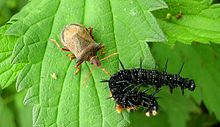Bidentate thorn bug
| Bidentate thorn bug | ||||||||||||
|---|---|---|---|---|---|---|---|---|---|---|---|---|

Two-toothed thorn bug ( Picromerus bidens ) |
||||||||||||
| Systematics | ||||||||||||
|
||||||||||||
| Scientific name | ||||||||||||
| Picromerus bidens | ||||||||||||
| Fabricius , 1794 |

The Picromerus Bidens or bifurcated Bug ( Picromerus bidens ) is a bug in the family stink bugs (Pentatomidae).
features
The two-toothed thorn bug reaches a body length of 10 to 14 millimeters. Its basic color is dark brown, with two red dots on its pronotum. The species owes its German name to the two pointed, black-brown thorns on the sides of the pronotum. These are not yet developed at the nymph stages. The species is able to fly.
Occurrence
The species occurs in Europe and North Asia to Japan . It can be found in deciduous and mixed forests as well as in gardens and prefers moist locations, for example on the edge of the forest or in heather and dune landscapes, where the forage plants of many caterpillars and beetle larvae can be found.
Way of life
development
The two-toothed thorn bug is univoltine , there is only one generation each year. The females lay the eggs on top of the leaves where they hibernate. The larvae hatch in the spring and have five molts through to until the summer to imagines to be able to grow. The rate of development depends on the temperature and takes around 64.5 days at 20 ° C under laboratory conditions. Of these, the egg takes around 23 days to develop. If the days after the development into a mature animal are long and the nights are short, the first egg-laying takes place after a while. This prevents the young from hatching too early and then having to survive the winter as nymphs without food. Only in southern areas, where the days are shorter in summer and where there is no particularly harsh winter, do the females start laying eggs straight away. The nymphs can hibernate there in some cases.
nutrition
The bidentate bug bug lives predatory on caterpillars , beetle larvae and aphids . The nymphs live on the same prey as the adults. On nettles , for example, the species prey on caterpillars of the peacock , on ragweeds the Jacob's cabbage bear from the bear moth subfamily . Among the beetle larvae, the leaf beetles are the preferred prey. The choice of prey also depends on the seasonal availability of food. For example, it feeds on caterpillars of the scabiosa pied butterfly and other Melitaeinae in early autumn when other prey animals are no longer available. Iridoid glycosides found in the forage plants of these butterflies, e.g. B. Succisa pratensis , formed and ingested by them, serve, among other things, because of their bitter taste, the chemical defense against predators. The bidentate bug bug is not deterred by these substances. It is not yet clear whether the bugs can use these substances themselves for chemical defense against predators.
Two-toothed thorn bugs eat two to five prey a day and are therefore used for biological pest control. Since the bugs and their nymphs are resistant to some pesticides such as methoxyfenozide or spinosad , they can play a role in integrated pest management.
Bidentate thorn bugs can be a regulating factor in the population dynamics of many butterfly species. Both nymphs and adults feed on caterpillars, among other things. It does not matter whether the caterpillars move freely or are protected by a web. With the help of their proboscis , in which the mandibles have stinging appendages, they penetrate the web and the skin of the caterpillars. The bugs then take a few steps back, so that the proboscis anchors itself in the skin of the caterpillars and even large prey can no longer wriggle away. Adult butterflies are also attacked if they are caught in a spider's web or if they are prevented from flying by other circumstances.
Individual evidence
- ↑ Kamran Mahdian, Luc Tirry & Patrick De Clercq: Development of the predatory pentatomid Picromerus bidens (L.) at various constant temperatures. Belg. J. Zool., 138, 2, pp. 135-139, 2008.
- ↑ Dmitry L. Musolin, Aida H. Saulich: Summer dormancy ensures univoltinism in the predatory bug Picromerus bidens. Entomologia Experimentalis et Applicata, 95, 3, pp. 259-267, 2000 doi: 10.1046 / j.1570-7458.2000.00665.x
- ↑ a b c Martin Konvicka, Vladimir Hula and Zdenek Fric: Picromerus bidens (Heteroptera: Pentatomidae) as predator of the Checkerspot Euphydryas aurinia (Lepidoptera: Nymphalidae). Entomologica Fennica, 16, pp. 233-236, 2005 PDF
- ↑ Kamran Mahdian, Luc Tirry & Patrick De Clercq: Functional response of Picromerus bidens: effects of host plant. Journal of Applied Entomology, 131, 3, pp. 160-164, 2007 doi: 10.1111 / j.1439-0418.2006.01124.x
- ↑ Kamran Mahdian, Thomas Van Leeuwen, Luc Tirry and Patrick De Clercq: Susceptibility of the predatory stinkbug Picromerus bidens to selected insecticides. BioControl, 52, 6, pp. 765-774, 2007 doi: 10.1007 / s10526-007-9075-3
literature
- TRE Southwood and D. Leston: Land and Water Bugs of the British Isles. Frederick Warne & Co. Ltd., 1959
- E. Wachmann , A. Melber & J. Deckert: Bugs. Volume 4. Revision of the bedbugs in Germany, Austria and German-speaking Switzerland, Goecke & Evers, Keltern 2008, pp. 85–89. ISBN 3-931374-49-1
- E. Security guard: watch bugs - get to know . J. Neumann - Neudamm, Melsungen 1989 ISBN 3-7888-0554-4
Web links
- Picromerus bidens at Fauna Europaea
- Two-toothed thorn bug profile on Insektenbox.de
- Two-pointed bug, two-toothed thorn bug in nature in NRW
- Image of an early stage and the last Nymphnestadiums the bidentate thorn bug
